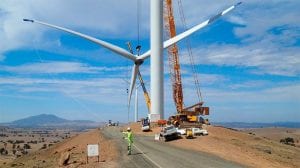As the mainstream press gets excited about discovering news – almost two months old – that the Solar Flagships program is in danger of collapse because the two chosen consortia failed to obtain funding by the December 15 deadline, the main game in the Australian solar industry has moved – from the corridors of power in the Federal Parliament to the more modest resources of the ACT Legislative Assembly.
The $1.5 billion Solar Flagships program was dreamed up by former Prime Minister Kevin Rudd and his staffers in May 2009, as a largely symbolic gesture, as much of the government’s clean energy policies have been. It is now being treated that way by the solar industry itself: the real action is happening in the ACT, where – as we wrote last week – the local government has set in motion the nation’s first “reverse auction” for a large scale solar feed in tariff.
The rules and the detail of the auction have only just been announced, and the first stakeholders’ information meeting will not be held until this Friday, but already there is widespread talk that the bidding for the first round of the 40MW scheme will be extremely competitive, with numerous proposals (two dozen or more) in the range of 3MW-5MW, and several larger proposals in the 15MW-20MW range.
The game-breaking potential of the ACT auction will be in the prices offered, with some suggesting that bids could come in the $120/MWh-$150/MWh range – the area were solar can compete with daytime wholesale energy costs without the need for subsidies, can match 2nd tier wind farms, and displace peaking gas plant, which commonly operate at these prices or more. It will also shatter the assumptions of federal policy makers, who have sought to design energy policy on the assumption that solar PV costs will not fall below $350/MWh before 2030
It is often said solar will remain too expensive for the Australia energy market because it cannot compete with the cost of coal-fired power generation, and average wholesale costs, at around $40-$50/MWh. But it doesn’t need to. Daytime energy prices are commonly above $100/MWh, and often much higher at the peaks, and it is here that the coal fired power generators make their profits. The arrival of solar has the potential to turn that model on its head.
The ACT auction is significant for a number of reasons. The solar industry has long pushed for a feed-in-tariff as the most effective mechanism, but this has been flatly rejected by Energy Minister Martin Ferguson, and the disaster around the poorly conceived and managed NSW rooftop solar tariff has trashed the idea in the minds of many a policy maker.
The difficulty with setting FiTs has been responding to the dramatic cost cuts that are achieved through the rapid employment they engender. It is like managing a bucking bronco. By having a reverse auction, the ACT can ensure that it gets maximum “bang for its buck” by having tenderers jockeying for the most cost effective installation.
Solar industry sources say there are some good reasons why the bidding in the ACT auction might be surprisingly low: a glut of cheap panels, improvements in mounting systems, and the ability of some developers/manufacturers to access relatively cheap finance – something which has been beyond the ability of the proposed 150MW flagship project at Moree.
Some developers may also be prepared to have their ACT project act as a “loss leader”. In Australia, the solar industry recognizes that more than half the cost reductions necessary to make it truly competitive will need to come from deployment. This includes installation, operations and maintenance, infrastructure and finance – and these costs can only be permanently reduced through “learning by doing.”
There are concerns that the bidding could attract some cowboy operators that could bid ridiculously cheap tariffs and then either not build the project or do it badly. However, most seem comfortable that the bidding rules established by the ACT government will ensure unviable projects will be weeded out, and the winning tenders will go to the lowest cost and the most credible offerings.
Reverse auctions are already being deployed successfully in some of the world’s biggest energy markets. In India, the world’s third-largest energy consumer, solar costs have been slashed through their reverse auctions, with the most recent in December awarding contracts for as little as $147/MWh (to French company SolaireDirect) – that is around 30 per cent cheaper than the global average of the previous year (although costs are falling by around that level each year in the solar PV industry). India had some problems in the initial round in December, 2010, with offers that lacked credibility. However, the state of Gujarat, which is also holding such auctions, has imposed a strict deadline on projects, which means their tariff is cut by a third if the solar plant is not operating by a certain deadline.
In India, these results are significant because the cost of coal fired power generation is relatively high as coal needs to be either imported or transported across the nation – or both. These bids put solar PV plants at a mere 35 per cent above the wholesale price of coal fired power, and little above the cost of new coal fired power generation. According to Bloomberg New Energy Finance, in energy auctions in Brazil, Uruguay and Peru, wind farm and solar park developers have won contracts to supply power at rates close to or below fossil fuel-based power.
In the ACT, however, bidders will need to be well prepared. For a start, they will need access to land, which could be at a premium as all projects must be developed within the confines of the territory, and on relatively flat land. One company, Elementus Energy, secured 300ha of land last July in anticipation of the auction.
The irony is that the $120-$150/MWh range being touted by the industry is in the same range that the Moree Solar consortium was seeking to pitch a power purchase agreement to energy retailers. It had little success, mostly because the electricity retailers are still flush with renewable energy certificates, and are still getting their mind around contracts that are pitched at peaking prices, and in such great quantities. The $923 million Moree consortium, which included Spain’s FRV, BP Solar and Australia’s Pacific Hydro, was also benefitting from a $305 million government grant – so its real costs per MWh were likely around $260/MWh or higher. By comparison, the 10MW Greenough River solar PV plant being built near Geraldton by Verve Energy, First Solar and GE, and is thought to be around $200/MWh. That project also benefits from a state government grant.
The sudden interest from the mainstream media in the Solar Flagships program means the government will be pressed to make a decision soon on its future. It has several options – allow an extension, and possibly scale back the size of the projects, hand over the opportunity to the losing short-listed candidates (two of whom have the backing of electricity retailers and should therefore have less trouble getting PPA) , plough the money back into an accelerated round 2, where smaller and more credible projects may be chosen, or forget the whole thing.
(Update. The government was pressed to make a decision very soon. Just a few hours after this article was published, the government announced this)
Whatever happens, it seems likely that if Labor government ministers want to have their photo taken near a solar plant to boost their clean energy credentials in the run up to the next federal poll, then they will have to form a queue behind ACT Chief Minister Katy Gallagher and the Energy Minister Simon Corbell, or hop on a plane and form a queue behind their WA equivalents in Geraldton.






